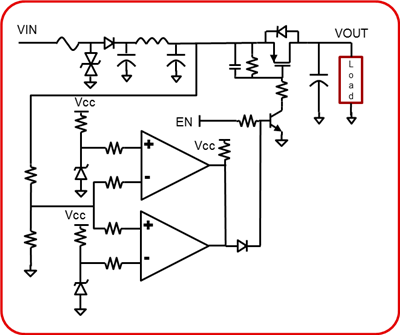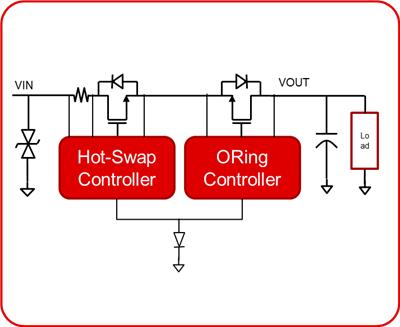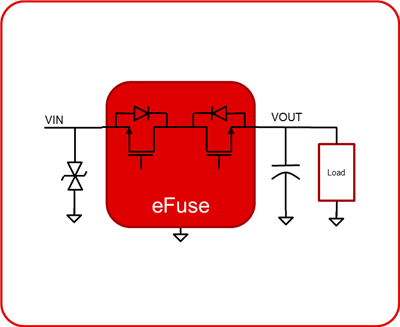SSZTAP4 october 2016 TPS2660
Any electronic systems are often subjected to harsh environments and threats such as electrostatic discharge (ESD), electrical fast transient (EFT) and lightning surges. Power designers must prioritize circuit protection to prevent system failure, especially for industrial applications with a 24V supply rail.
Circuit protection schemes are capable of protecting the power supply and the overall system from events such as overcurrent, short circuit, input inrush current, overvoltage, undervoltage, input reverse polarity protection (commonly known as miswiring) and reverse current blocking.
In this blog I will give an overview of several approaches to robust industrial power path protection including discrete implementation, hot-swap plus ORing controller approach and integrated implementation.
Discrete Implementation
 Figure 1 Discrete Protection
Scheme
Figure 1 Discrete Protection
SchemeA discrete implementation utlizes a power diode in series to protect the system from reverse polarity (miswiring) and reverse current. If a circuit draws 2A of current, it dissipates ~1W of power across the diode, which will increase the board temperature. Resonant circuit (L-C) filters and multiple TVS diodes control the input line transients during surge test (International Electrotechnical Commission (IEC) 61000-4-5).
The implementation utilizes a PFET (high-side switch) along with bi-polar junction transistor BJTs, operational amplifiers, Zener diodes, resistors and capacitors to fulfill all protection requirements. This system solution is bulky and has a larger bill of materials (BOM) count. Additionally, this implementation does not address thermal shutdown protection and current-limit accuracy variations with temperature.
By utilizing a traditional fuse, a discrete implementation protects against short-circuit events. The fuse takes milliseconds to seconds to break during short circuit, which can damage the load. Be sure to check out my colleague’s blog for more information on upgrading your fuse.
Hot-swap plus ORing Controller Approach
 Figure 2 Controller + MOSFET Protection
Scheme
Figure 2 Controller + MOSFET Protection
SchemeIntegrated Implementation (eFuse)
 Figure 3 Integrated Protection
Scheme
Figure 3 Integrated Protection
SchemeThe SOA protection of FETs and robust thermal protection ensures the protection of the eFuse, as well as the load in harsh environments. It is also suitable for space-constrained applications, as integration helps reduce the system solution by more than half.
One of these types of solutions is the TPS2660, the industry’s first 60V back-to-back FET integrated eFuse. The device is definitely worth considering for your new designs as it supports protection against inrush current, overcurrent, short circuit, input reverse polarity protection (miswiring), overvoltage and undervoltage conditions. It also provides current monitoring and fault indication for system diagnosis. The integrated 60V back-to back-FET architecture lets you design robust circuits and protect loads against industry-standard tests such as surge (IEC 61000-4-5), EFT (IEC 61000-4-4), and voltage dips and interruption tests in accordance with IEC 61131-2.
A robust and efficient power supply protection scheme is essential for electronic system design. With integrated protection devices, designers can create their system more simply, , efficiently and get to market faster. If you have a design which uses power path protection for 24V power supply rail, stay a step ahead and start designing today with the Input Protection and Backup Supply Reference Design for a 25W PLC Controller Unit.
Additional Resources
- For more details on how the TPS2660helps during industry-standard testing:
- Read the application note, “The TPS2660 Simplifies Surge and Power-Fail Protection Circuits in PLC Systems.”
- Learn more about TI’s eFuse products.